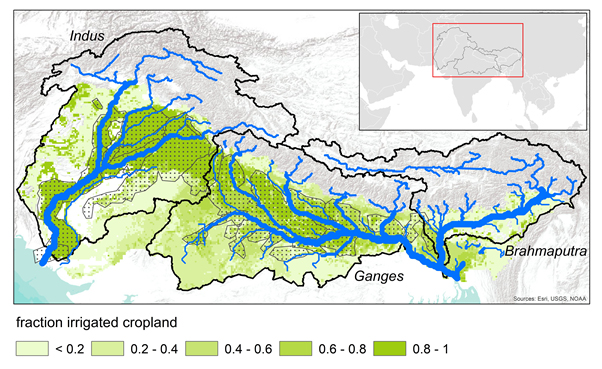Improving irrigation water use to ease the pressure on India’s farmers

Christian Siderius and Declan Conway highlight some of the barriers and opportunities to achieving more sustainable water use in the ‘breadbasket’ of India, at a time of unrest among many farmers faced with new laws they perceive threaten their livelihoods.
India’s farm protests and water stress
India is experiencing one of the largest protests in years. Since November 2020 hundreds of thousands of farmers have been camped just outside Delhi, demanding a repeal of three market-friendly farm laws. The laws are designed to loosen rules around the sale, pricing and storage of farm produce. While the immediate cause of the anger is Indian farmers’ deep distrust of these reforms, also driving the protest are long-standing concerns about increasing costs and reduced profitability of farming and its future as a respectable livelihood.
The depletion of groundwater is one outcome of India’s farm policies to date – prices for wheat and rice have been guaranteed by the Government, leading to over-production in the farming heartlands of Punjab and Haryana, facilitated by over-abstraction. Vast volumes of water used for irrigation, and the high energy requirements for pumping that water from ever deeper levels below the ground, are heavily subsidised to maintain and increase production, placing a large burden on state finances as well as the local environment. At the same time, pumping, as it often involves the use of inefficient diesel pumps, contributes to increasing greenhouse gas emissions from agriculture that counteract climate change mitigation efforts. Farmers in the region need support to move away from producing an excess of subsidised, water-intensive crops such as wheat, paddy rice and sugarcane.
Our new research highlights some of the barriers and opportunities to achieving less intensive water use to support sustainability in one of the world’s most intensively irrigated areas (see Figure 1).

A hotspot for climate change impacts and water stress
The region from which a large part of the protestors originate, fertile land in north-western India known as the ‘breadbasket’ of South Asia, fed by the tributaries of the Indus River, has been identified as water stressed and a climate change hotspot. Unsustainable groundwater use has long masked the region’s water problems; groundwater is abstracted much faster than it is replenished and levels are falling rapidly in many areas.
Partly fed by glacier and snowmelt in the Hindu Kush Himalaya mountains, irrigation water supply and food production will also be increasingly affected by higher temperatures, changing precipitation patterns and shifts in mountain runoff with glaciers and snow cover receding. Strategies will be necessary to maintain current levels of production in the face of groundwater depletion and changing runoff patterns.
Population growth in the wider region shown in Figure 1, which is part of the Indo-Gangetic plain and already home to almost 1 billion people, is adding increasing pressure on resources, raising further concerns over water, energy and food security.
Financial feasibility of water conservation in agriculture
Improved water management in a sector that accounts for over 90% of India’s water resource use has long been advocated by various government agencies. Measures include different ways of applying irrigation such as drip and sprinkler systems, storing water harvested from slopes and gullies in farm ponds, or covering the soil with crop residues or plastic to reduce water loss through evaporation.
Despite the range of measures on offer, uptake of water conservation has generally been poor. Affordability is a major issue and the extent to which the benefits compensate the costs of these measures is not well understood in academic or policy circles. Additionally, for those who use too much water there is generally no incentive to use less. Coordination to match supply and demand is needed.
A key issue is that water use efficiency measures often do not generate the benefits initially expected. Water lost from inefficient use of water upstream is in large part reused downstream, where the water has re-entered the river system; therefore the benefits of water conservation measures tend to be overstated – this can be termed an ‘irrigation efficiency paradox’. Including this downstream use in calculations is important for estimating the actual efficiency of water conservation measures at the river basin scale.
A more accurate way to calculate the costs and benefits
In our paper published in Earth’s Future, we introduce a novel method to compare the costs of water conservation measures with the added value that reallocation of saved water might generate if used for expansion of irrigation.
Based on water accounting through the use of a detailed computer model that simulates the hydrology, irrigation demand and supply, and crop growth, we estimate the cost and benefits for three major river basins in South Asia: the Indus, Ganges and Brahmaputra (see Figure 1 above). We show that only just over 20% of potential saved water – that which is physically possible to save – would be realised if financial feasibility is taken into account; the majority of water conservation measures are simply too costly. This is because the profits from staple crops are low, meaning the added value of more irrigation is limited. In addition, net water savings of the least expensive measures are modest.
However, despite these limited water savings and the modest expansion of irrigation they would allow, their implementation would improve farm profits in a region where farming profitability is low.
Increasing the efficiency of policies and easing pressure on farmers
Our results represent a lower estimate. The costs of water conservation might decrease: cheaper renewable energy should reduce the cost of technologies such as integrated solar-drip systems, making water conservation measures more accessible to a larger group of farmers – although there is a danger that cheaper energy will promote pumping. Higher crop prices or shifting to crops returning higher profits will increase the value of irrigation water, leading to a higher demand and more opportunity to conserve and trade. The results show that it is necessary to coordinate within river basins, as regions with unmet demand are not necessarily close to regions where water can be best conserved.
With greater water stress expected in a changing climate and an increasingly urbanised world, our results have important implications for prioritising the design of efficient policies to support adaptation investments that make financial sense to farmers and therefore have a higher likelihood of adoption.
While water conservation will not take away the immediate concern over India’s farm laws, improved water resources use will ease the pressures on farmers and allow more time and opportunity to implement necessary reform.
‘Financial feasibility of water conservation in agriculture’, by Christian Siderius, Hester Biemans, Declan Conway, Walter Immerzeel, Jonas Jaegermeyr, Bashir Ahmad and Petra Hellegers has been published in Earth’s Future, available at https://agupubs.onlinelibrary.wiley.com/doi/full/10.1029/2020EF001726 (open access).
The views in this commentary are those of the authors and do not necessarily represent those of the Grantham Research Institute.

